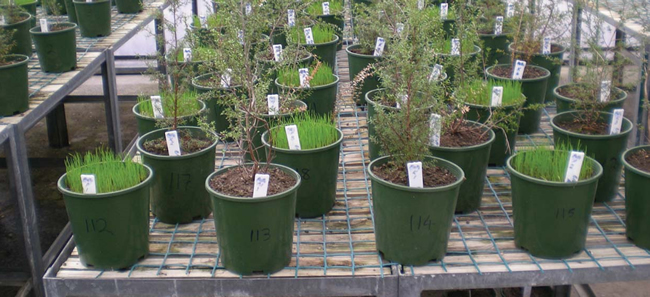Mānuka and organic waste – uncovering a potential partnership
The ever-increasing need for environmentally sound waste disposal has put pressure on society to investigate the recycling of organic wastes such as biosolids.
Biosolids, a product of human excreta, are carbon-rich and contain high concentrations of valuable nutrients that can have high fertiliser value. They are effective for rebuilding degraded soil, e.g. in land converted to pine forests. Disadvantages are that biosolids can be a vehicle for numerous contaminants, including human pathogens, and this helps to explain why in New Zealand most biosolids are placed in landfills. Forests are considered suitable for receiving biosolids because this land use is not directly linked to the human food chain, and applications can be made year-round.
Potentially, plants with antiseptic qualities could be grown in waste-amended soil to mitigate microbial contamination. Although there is much research into the source of the antimicrobial activity of oils and honey from New Zealand native Leptospermum scoparium (mānuka), there have been no studies into the impacts of these antimicrobial properties on the wider soil environment. Preliminary studies conducted by the Centre for Integrated Biowaste Research (CIBR) indicate inhibition of pathogen growth and accelerated die-off of pathogens when in contact with mānuka components. In the current project we have been further investigating the potential for antimicrobial properties of mānuka to mitigate environmental contamination from biosolids-borne pathogens in situ.
Mānuka is already widely used in land restoration projects in New Zealand due to its hardy, tolerant nature. Both mānuka and a morphologically-similar species, kānuka (Kunzea ericoides), are pioneer species that colonise disturbed environments in New Zealand and South Australia. This, together with its antimicrobial properties, makes establishment of mānuka plantations a viable option, and if achieved on low quality or degraded land, where biosolids can be recycled, then this system has added potential to generate an economic return.
 |
| Figure 1. Potted plants of perennial ryegrass (Lolium perenne), mānuka (Leptospermum scoparium) and kānuka (Kunzea ericoides) used to investigate die-off of pathogens in soil. |
Pot trials were established containing perennial ryegrass (Lolium perenne), mānuka and kānuka (Figure 1), which were subsequently spiked with the pathogen indicator species E. coli and Salmonella, in two separate experiments. Die-off of these pathogens in the soil underneath growing plants was assessed over time. Results show that E. coli and Salmonella survival is reduced in soil underneath mānuka (and kānuka) when compared to a pasture control. Further, the time taken to achieve 90% reduction in E. coli (decimal reduction time) was just 5 and 8 days for kānuka and mānuka respectively compared with 93 days for rye grass. These observed inhibitory effects may be due to mānuka antimicrobial properties, the nature of which requires further investigation. In addition to this work, CIBR is currently investigating the mechanisms behind how mixing biosolids with degraded soils can improve mānuka growth, as well as the effects of mānuka (and other indigenous plants) on nitrogen cycling and other processes in soils.
Jennifer Prosser – Centre for Integrated Biowaste Research
P: 04 914 0700 E: jennifer.prosser@esr.cri.nz
Jacqui Horswell – ESR
Brett Robinson, Roshean Woods – Lincoln University
